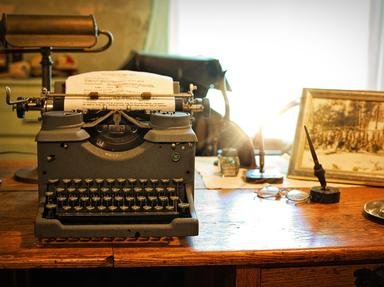Quiz Answer Key and Fun Facts
1. Which poet is remembered for three major works of Latin literature, the "Eclogues" (or Bucolics), the "Georgics" and the epic "Aeneid"?
2. The writer Kalidasa is widely regarded as the greatest poet and dramatist in which language?
3. This French poet's first published collection, "Stances et Poèmes" in 1865, included his best-known work, "Le vase brisé". He is best-remembered, though, for an acknowledgment of his work just a few years before his death in 1907. Who is he?
4. Including non-religious, Buddhist and Jainist philosophies and written over a period of almost a thousand years, "Cilappatikaram", "Manimekalai", "Civaka Cintamaṇi", "Valayapathi" and "Kuṇṭalakeci" are considered "The Five Great Epics" of literature in which language/culture?
5. This poet and dramatist is often referred to as "The Father of Realism" and was one of the founders of "Modernism" in theater. His first play, "Catiline", written in 1848-49 was performed the following year with a pseudonym as the author's name. Now acknowledged as his country's greatest dramatist and one of the world's most performed playwrights, who is he?
6. Particularly renowned for his epic poem about global discovery, the 16th-Century writer Luís de Camoes is considered the greatest poet in which European language?
7. Published in 1922 and widely regarded as "one of the most important poems of the 20th century" and a central text in "Modernist" poetry, the 434-line 'magnum opus' of which American-born poet contains the famous line "April is the cruelest month"?
8. Miklos Zrinyi, a statesman and military leader, had his poetry published in 1651 under the title 'Adriai tengernek Syrenaja ("The Siren of the Adriatic Sea"), the first epic poem in the literature of which country?
9. The "Ellesmere Manuscript", which is housed at the Huntington Library in San Marino, California, is one of the few remaining complete original copies of which important literary work? Its author was also the first in a line of writers that includes the likes of Dryden, Dickens, Browning, Hardy, Kipling and many others.
10. To conclude, we return to where we started, and a writer from ancient times, this time a Greek. Sometimes called "The Father of Comedy", which ancient Greek dramatist from the 5th-Century B.C. penned the plays "The Acharnians", "Clouds", "Peace", "The Birds" and "The Knights"?
Source: Author
EnglishJedi
This quiz was reviewed by FunTrivia editor
agony before going online.
Any errors found in FunTrivia content are routinely corrected through our feedback system.

